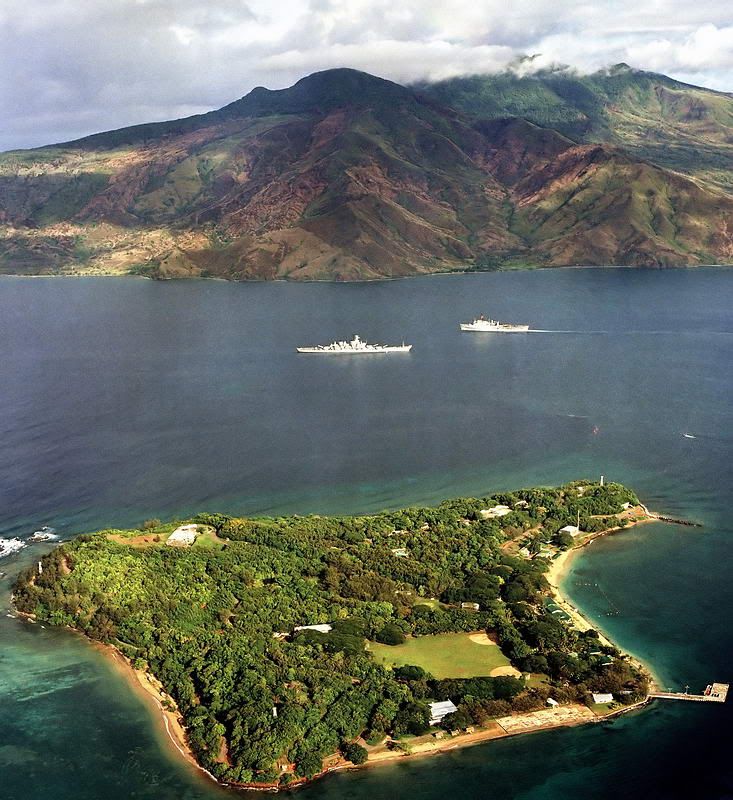Post by fots2 on Jun 12, 2011 15:09:23 GMT 8
In 1905 the US Army acting under the authority of the 58th Congress purchased the 96-acre Grande Island at the mouth of Subic Bay and began to fortify it. The island divides the entrance of the bay into two channels. A main ship channel lies to the west of the island and is 3000 feet wide with a minimum depth of 60 feet. The other channel to the east is 2000 feet wide but has only a minimum depth of 12 feet making it passable only to small craft.

Map of Subic Bay (herephilippines.co.uk/subicbaymaps.aspx)
Due to the island's limited size it was proposed to mount two 12-inch and four 6-inch disappearing guns. This was later changed to two 10-inch and four 6-inch disappearing guns and six 3-inch guns all mounted in five batteries. The fortifications were assigned the name Fort Wint in honor of Brigadier General Theodore J. Wint who had served in the U.S. Army during the Civil War, Indian campaigns, the War with Spain and the Philippine Insurrection. Fort Wint's batteries were assigned the name of Warwick, 10-inch; Woodruff and Hall, 6-inch, and Jewell and Flake, 3-inch.
The 10-inch disappearing guns as installed at Fort Wint were model 1895 guns manufactured in 1903 and 1906 by the Army's Watervliet Arsenal in New York and were mounted on model 1901 carriages. The 6-inch guns were model 1905 while the 3-inch guns were model 1903. The 10-inch and 6-inch guns were never removed during the life of Fort Wint but four of the 3-inch guns were removed during the 1930s. Only one of these 3-inch guns was ever replaced and that was with a naval 3-inch gun. To properly operate these guns at Fort Wint and the proposed defensive mine field in front of Subic Bay, the Army in 1915 stated that Fort Wint's wartime complement would be 22 officers and 448 men of whom 19 officers and 319 men would man the fort's guns.

1921 map of Grande Island
During the decades of the 1920s and thirties Fort Wint was maintained only on a caretaker basis. This was the result of a 1921 cut in personnel of the Philippine Coastal Defense from 3,600 to 800 men; but the force was later increased by 1,600 Philippine Scouts, native Filipinos serving in the U.S. Army. To train these men Fort Wint was reactivated in 1936 as a Coastal Defense School.
During these two decades no program of modernization was carried out at Fort Wint to update its defensive works in the face of the threat of airpower and improvements in warship construction. This failure was a result of the signing of the Washington Naval Treaty in 1922 which forbade the updating of American outposts in the Pacific. (The above text is from Corregidor.org)

1935 map of Grande Island. When compared to the 1921 map, note fewer structures after years of deactivation.
Post war to the present:
- After a brief period of abandonment the island transformed into an R&R location (fleet recreation area).
- In the 1960s, four 3-inch rapid fire pedestal mount guns and the two 10-inch disappearing guns were removed and reassembled in the US at two Washington State Parks.
- In May 1975, the aircraft carrier USS Hancock (CVA-19) unloaded her cargo of Vietnamese refugees on Grande Island. This temporary processing center was their first stop after the fall of Saigon.
- Today a portion of the island has been converted into a tourist resort.

Aerial view of Grande Island during its R&R days. Note the two ball fields.

Google satellite view of Grande Island. The ball fields are now a swimming pool (aqua) and a wave pool (green). In the photo, the resort covers the top beach part of the island including the dock. The batteries are all hidden by vegetation with the exception of the big 10-inch gun battery (Warwick) which appears near the bottom.

Fort Wint Dock (1940 or 1941, Paul Cornwallis photo)

(1940 or 1941, Paul Cornwallis photo)

Engineer’s Quarters and Post Exchange (1940 or 1941, Paul Cornwallis photo)

Post Hospital Dispensary (1940 or 1941, Paul Cornwallis photo)
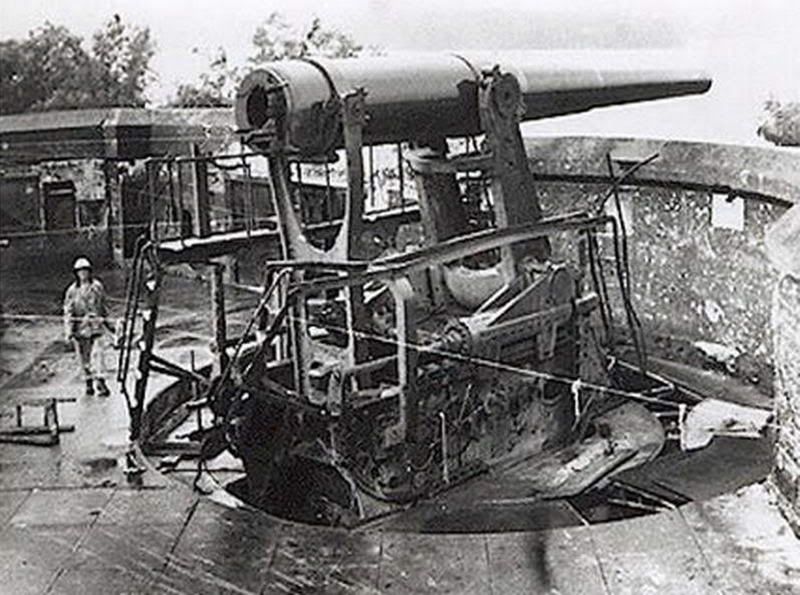
Battery Warwick 10-inch gun on a disappearing carriage

Loading one of Battery Warwick’s guns

Fort Wint’s 10-inch guns are now located at Fort Casey, Washington.

Another view of Fort Casey.

A sample of the 3-inch Rapid Fire pedestal mount guns that were installed in Batteries Jewell and Flake. (photo not from Fort Wint)

A sample of the 3-inch Rapid Fire pedestal mount guns that were installed in Batteries Jewell and Flake. (photo not from Fort Wint)

One of the 6-inch guns mounted on a disappearing carriage. Batteries Hall and Woodruff each had two of them. (1968 photo, source unknown)

One of the 6-inch guns mounted on a disappearing carriage. Batteries Hall and Woodruff each had two of them. (1968 photo, source unknown)
To visit Grande Island today requires a ride on a ferry operated by the resort. You can stay overnight if you wish or just book the day trip as I did.

The Grande Island Resort ferry terminal

The ferry is waiting at the dock.

Grande Island Resort ferry.

Looking along the dock. Subic Bay is surrounded by mountains.

As you approach Grande Island all the buildings we see belong to the resort.

After twenty minutes or so on the ferry you arrive at the Grande Island dock.

Looking down the dock towards the Reception and Restaurant building.
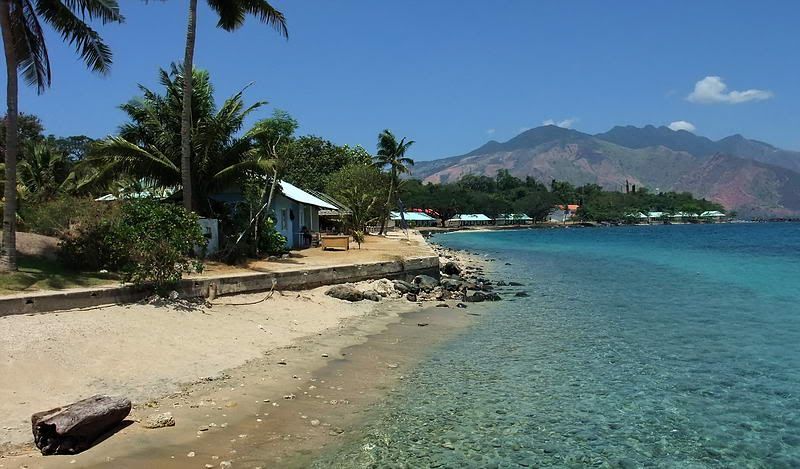
View of the beach in front of the resort.
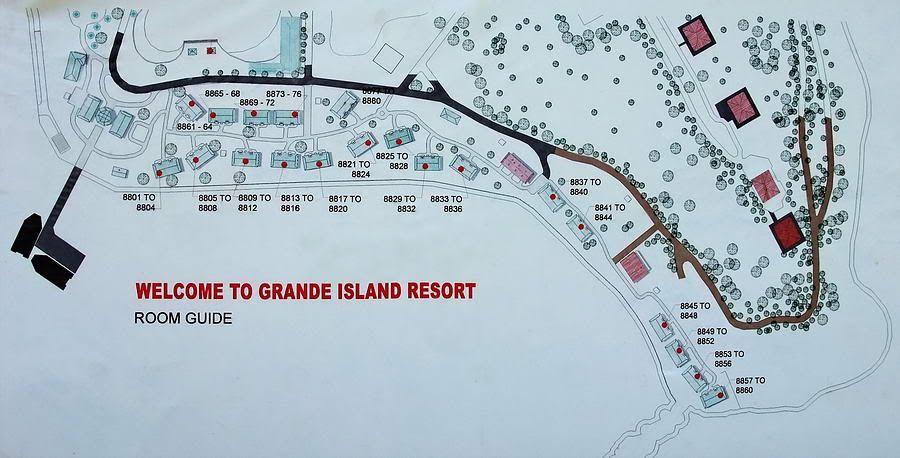
Layout of the Resort. I will show more of the Grande Island Resort later.
After side stepping a couple employees trying to herd me into the restaurant, I start my exploration of what was Fort Wint.
The first thing I notice is that the island is larger than I anticipated. Maps and photos are deceiving until you get your feet on the ground. Also, old maps do not show any of the current roads/paths so I actually found it a bit confusing at first. Now that I have my bearings the next trip will be much more efficient.
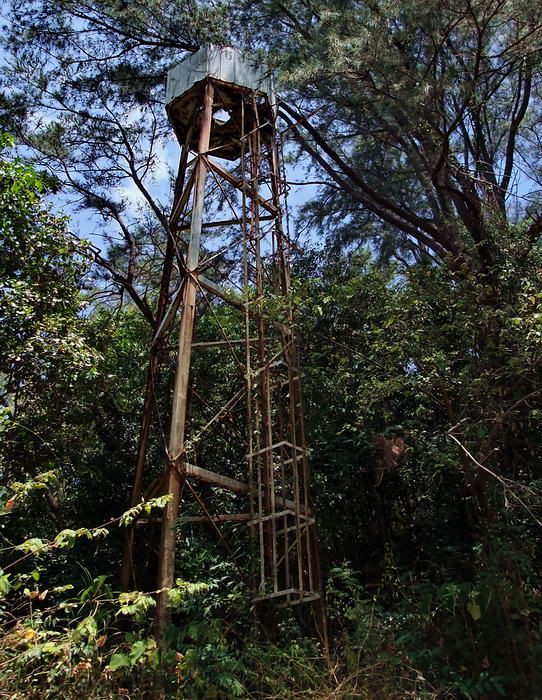
Away from the Resort, I see the first of three guard towers.
Since time was limited I decided to hit the main sites first. The most impressive is Battery Warwick which survived the war intact. Even though both big 10-inch guns are gone, it is still interesting to walk around. Immediately I notice that years of scrapping has not taken place here or at least, not so extensively. Most original metal doors and screens remain where only a few still exist on all of Corregidor Island.
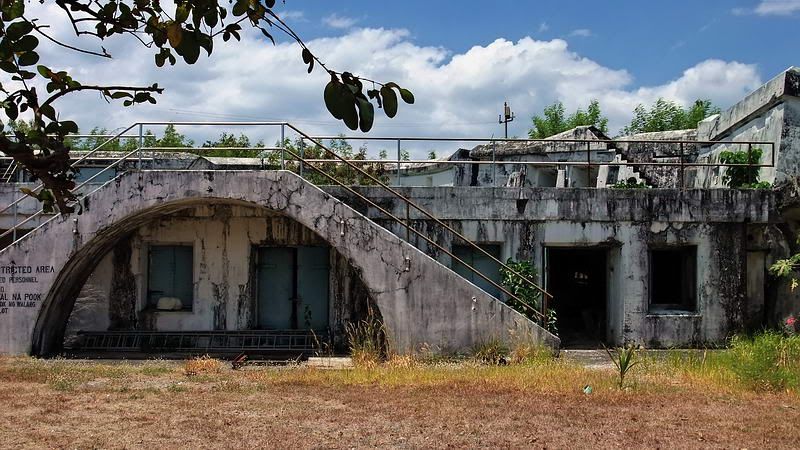
Battery Warwick behind the Gun #1 position. Note the slanted building to the right. There is some structural failure at this corner of the battery. The parapet seems to be collapsing here.
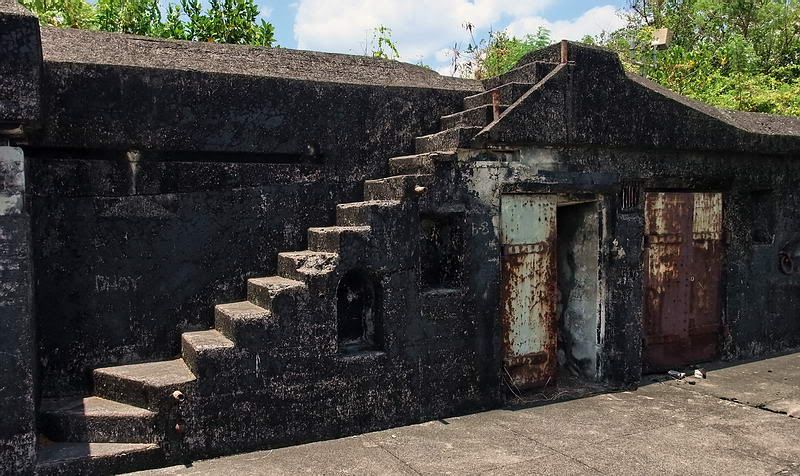
Note the metal doors still there and no battle damage to the concrete.

Gun #2 position is full of grass now.
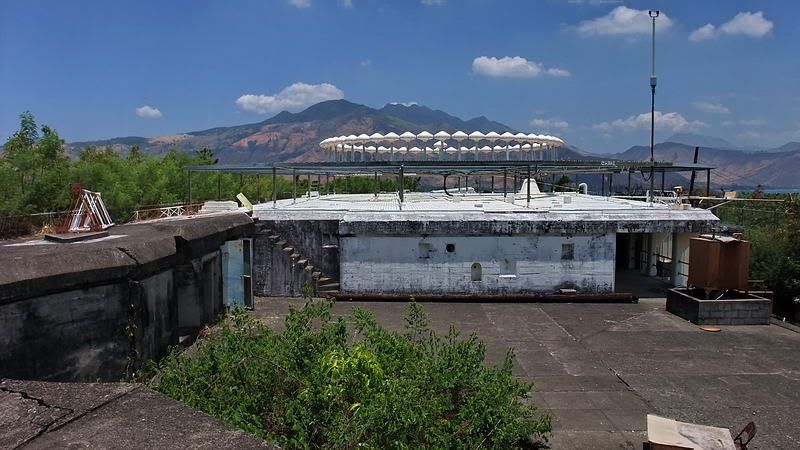
Looking across the battery from near the Gun #2 position.
I had better explain the ‘Alien landing site’ you see here. This is the antenna for an aircraft navigational aid known as DVOR (Doppler VHF Omnidirectional Radio range).
So why does this radar antenna look so strange? The answer is simple. “Although older antennas were mechanically rotated, current installations scan electronically to achieve an equivalent result with no moving parts”.
I assume it is not in-service now as the place was abandoned. The radar was scavenged for parts last year when a similar DVOR in Manila failed. The nearby Subic Bay International Airport (former Cubi Point NAS) is losing money since FedEx left and there is talk of closing it.
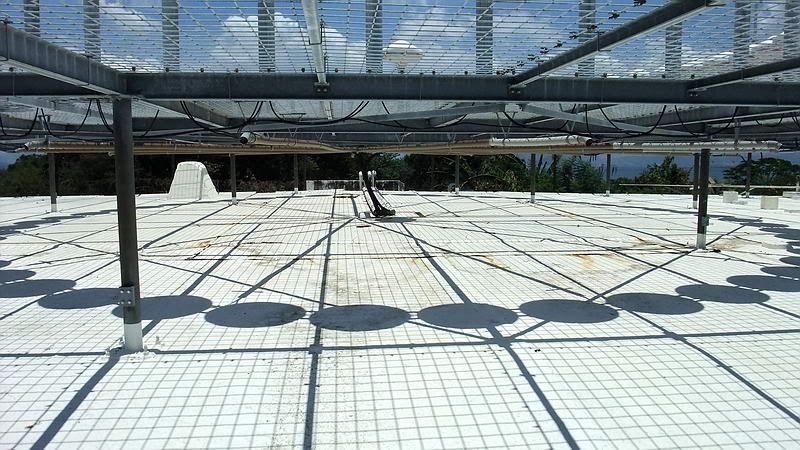
Closer view of the radar antenna.
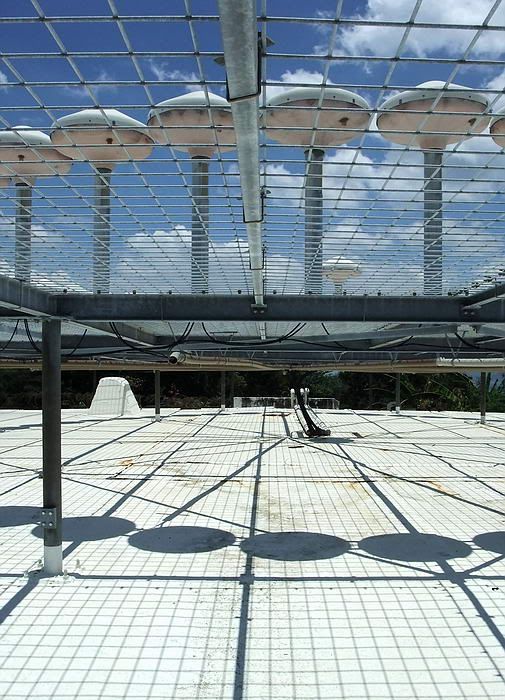
Another view.
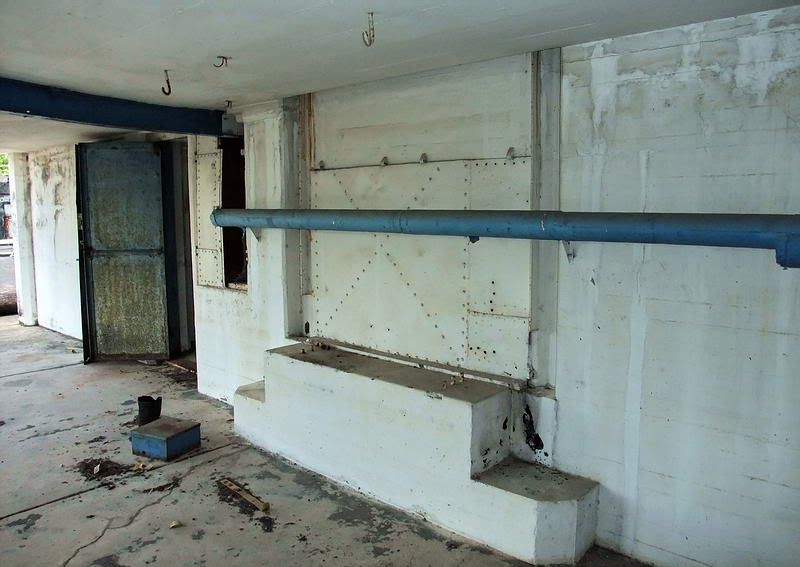
This is the area where powder and shells for the guns was brought up from the magazines below. These look like original doors also.
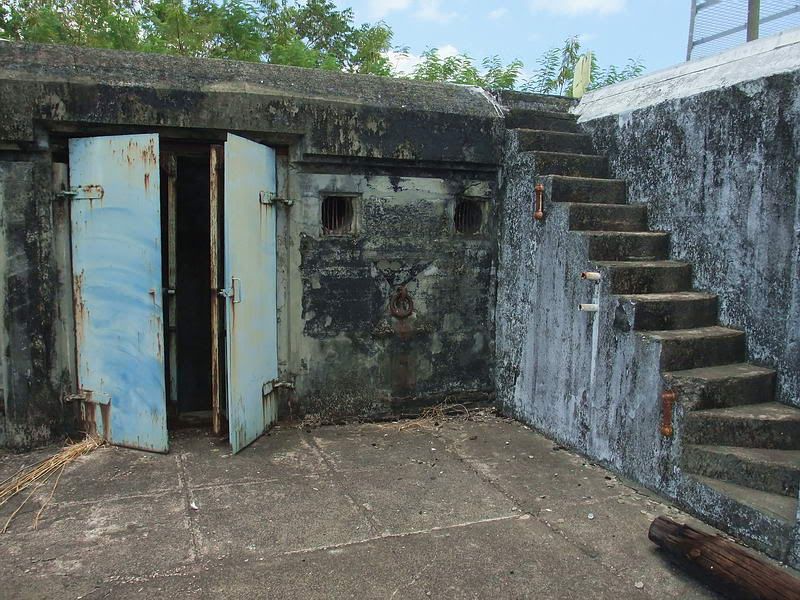
To the right of Gun #2.
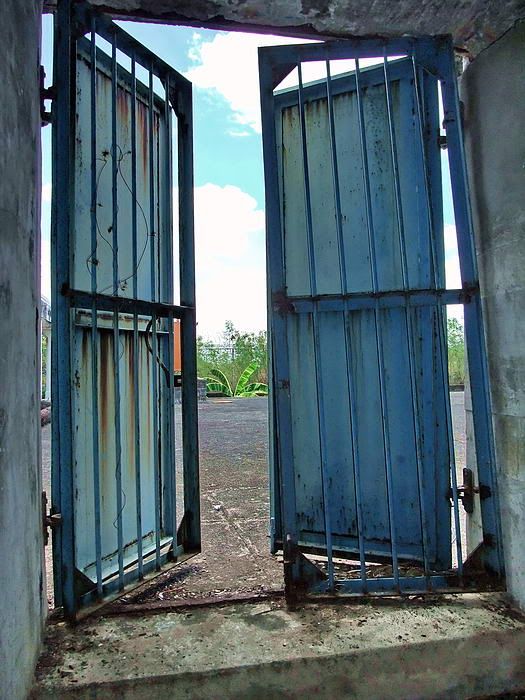
The outer solid metal doors have inner barred doors which I have not seen before. This concrete stairway leads down to the magazines.
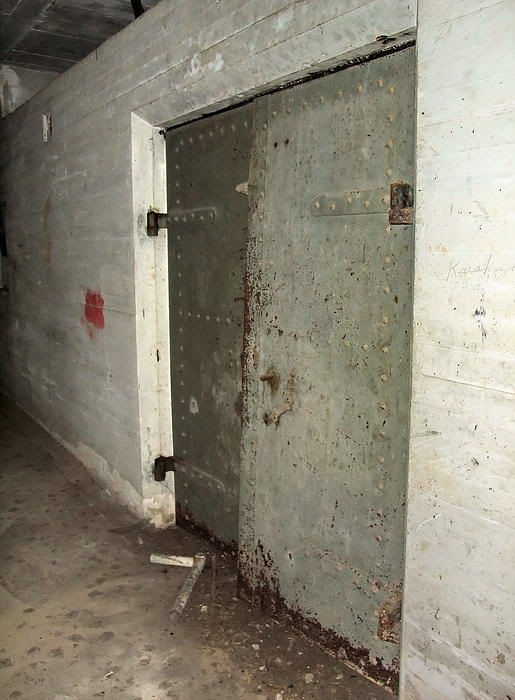
Rear door to one of the magazines.
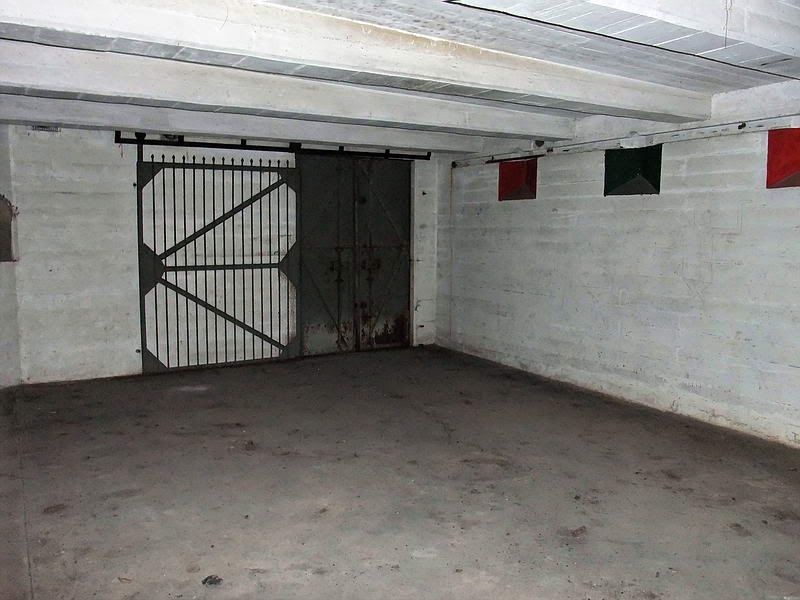
Magazine interior looking towards the front door. The inner door with bars rolls on a track.
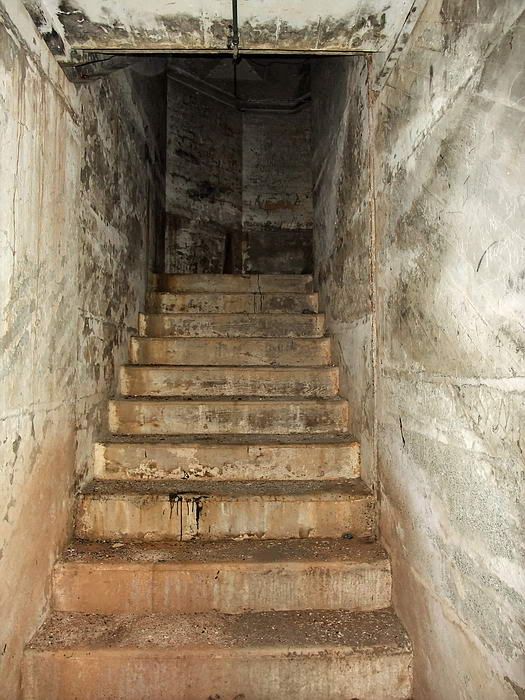
Stairs up to the Gun #1 position.
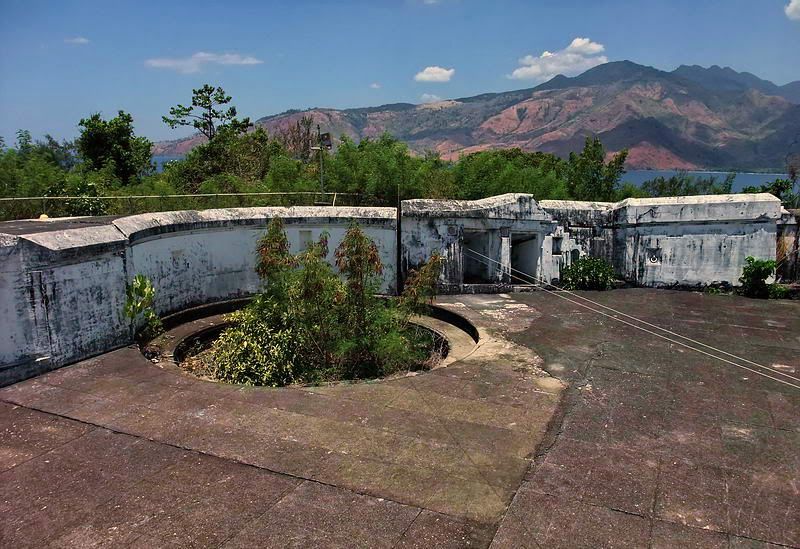
Gun #1 position.
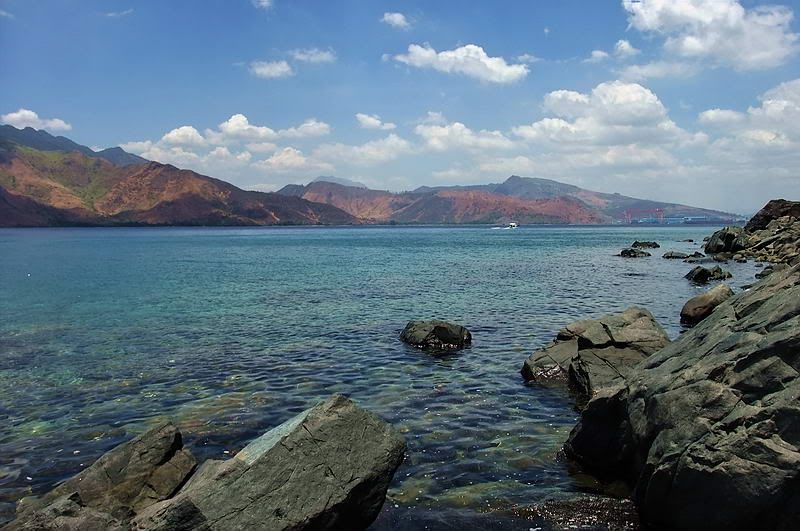
The view from the rocky shore at the opposite side of the island from the Resort. This is the wider of the two channels leading into Subic Bay. The blue buildings in the distance is the Korean Shipyard.
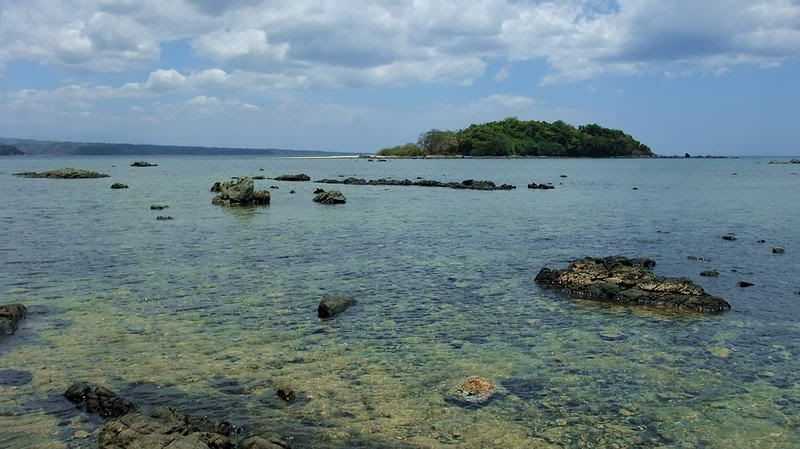
To the south of Grande Island is Chiquita Island. This low tide view makes it look like I could walk over there.
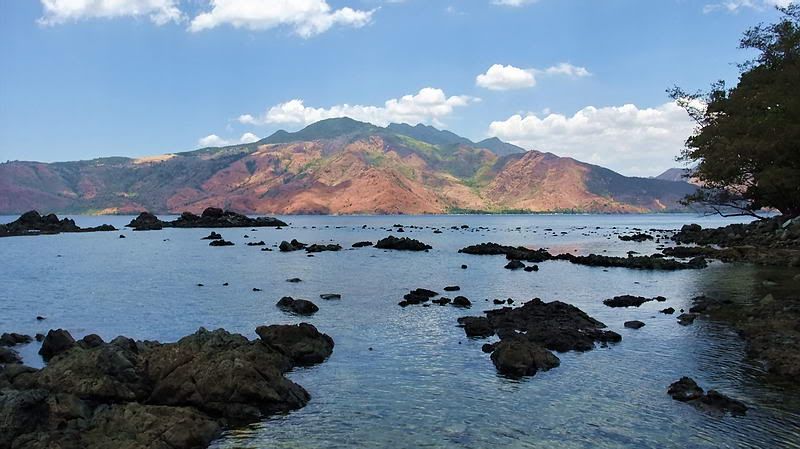
Another low tide view. Big clouds created quite a bit of contrast that day.
Battery Jewell had four 3-inch Rapid Fire guns mounted on pedestals. Between each of the gun positions were three reinforced rooms (total of nine) in which I assume most or perhaps all were magazines. This design made the battery quite long but narrow. In the center of the battery were double steps to the Battery Control Station. All guns are gone now.
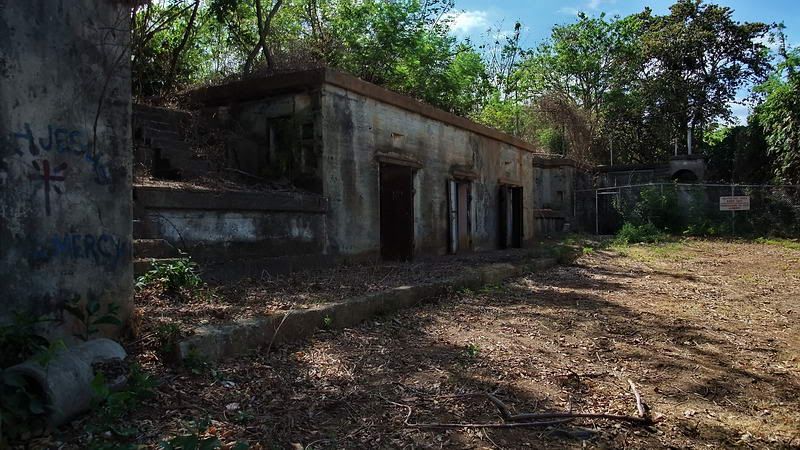
Rear view of half of Battery Jewell. Gun position #4 is in the foreground and the arched area with the pipes on top is the Battery Control Station. The wire fence surrounds part of the battery which was used years ago as some sort of radio station. It is abandoned now.
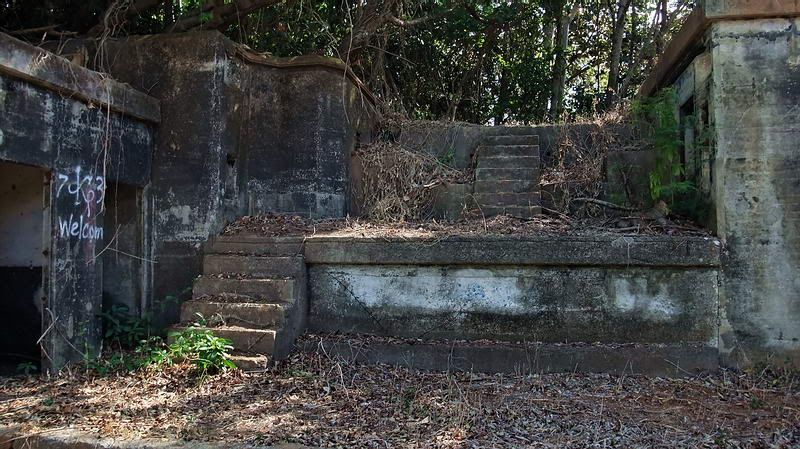
Gun position #4 is at the top of the steps.
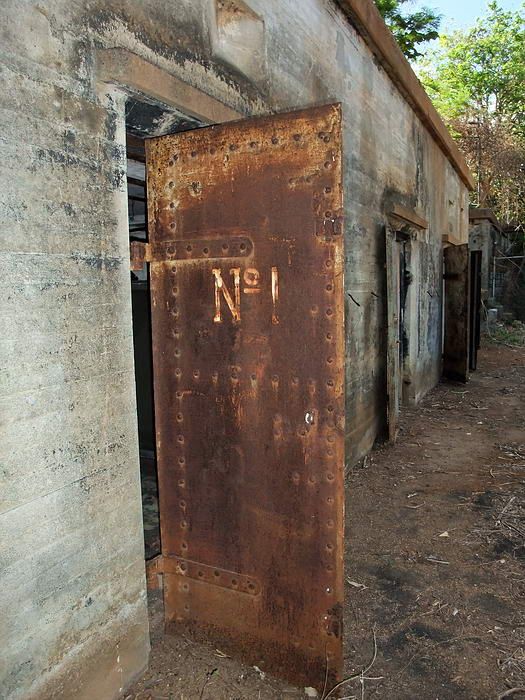
The three magazines between guns #3 and #4. The rooms seem to be storage places for the Resort’s miscellaneous junk.
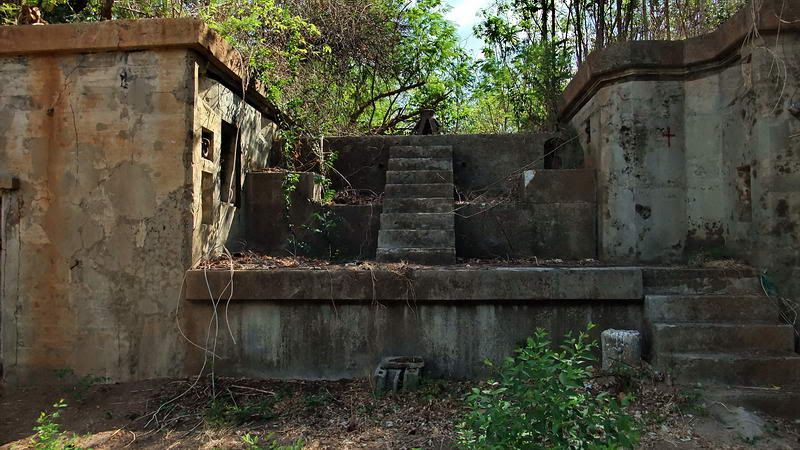
Gun position #3 is at the top of the steps. This position is unusual in that the metal gun mount is still there.
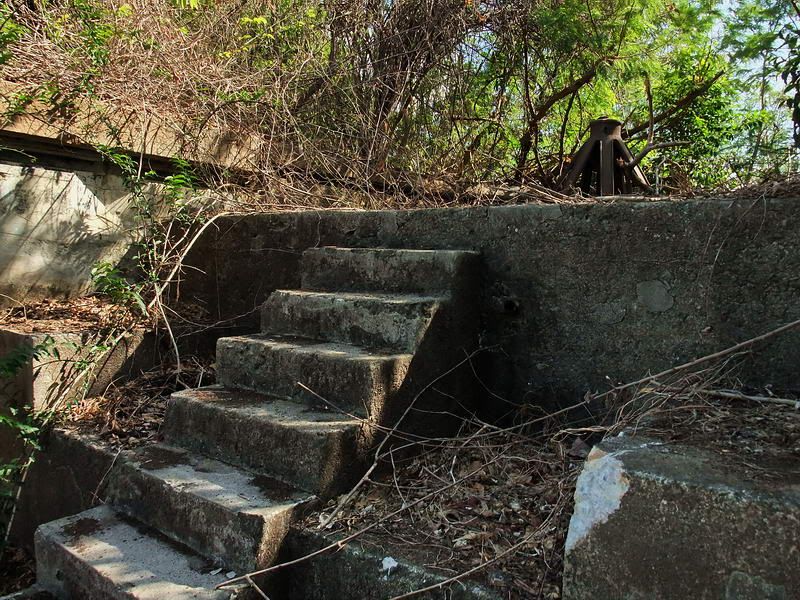
Gun #3 mount.

Close-up of the mount looking towards the front of the position.
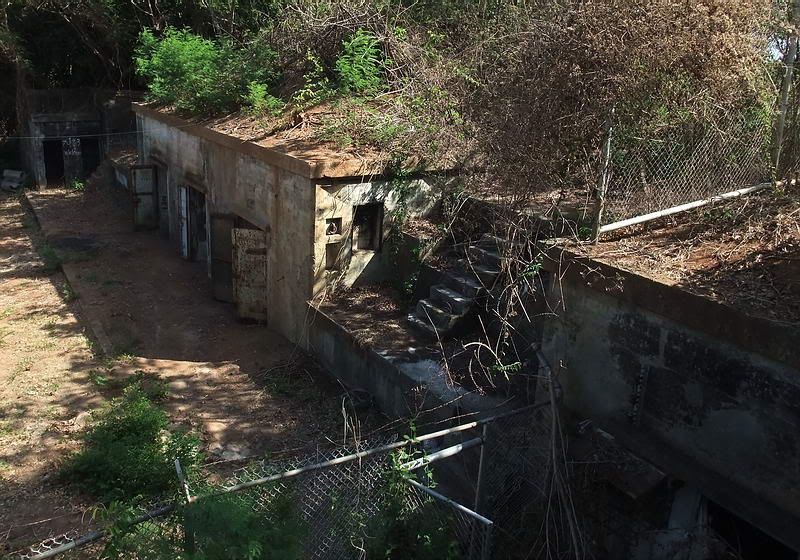
Standing beside Battery Control looking across gun positions #3 and #4. Magazines No.1, No.2 and No.3 are between those positions. Magazines No.4, No.5 and No.6 are almost under me and No.7, No.8 and No.9 are to my right.
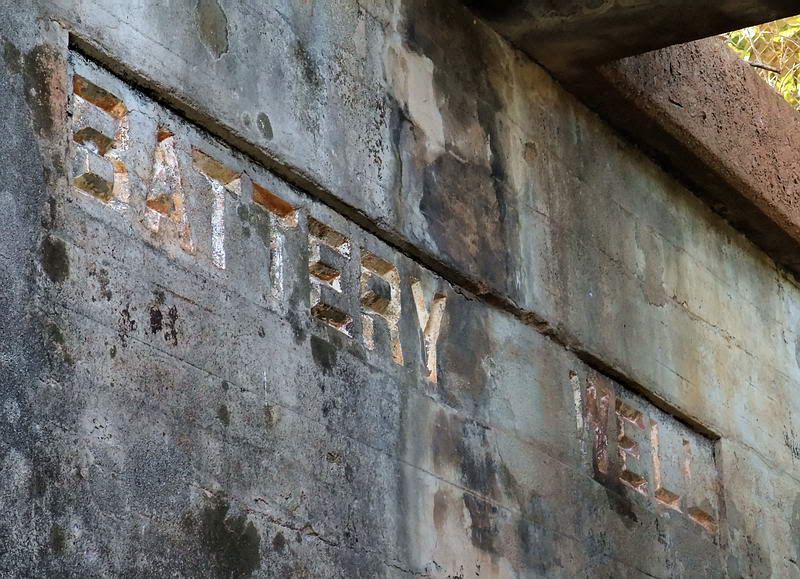
Does anyone know why Battery Jewell in now misspelled?
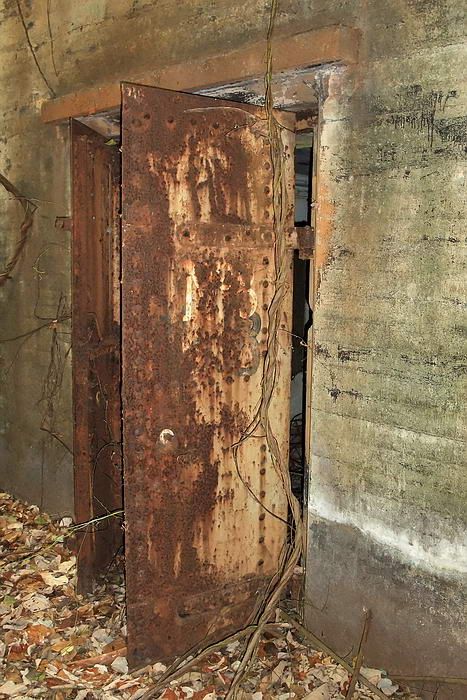
Magazine #5.
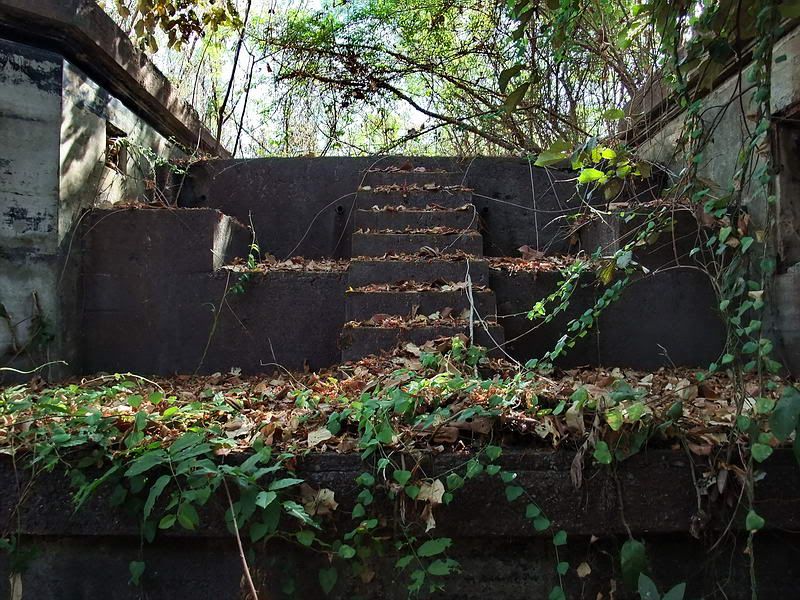
Gun position #2.
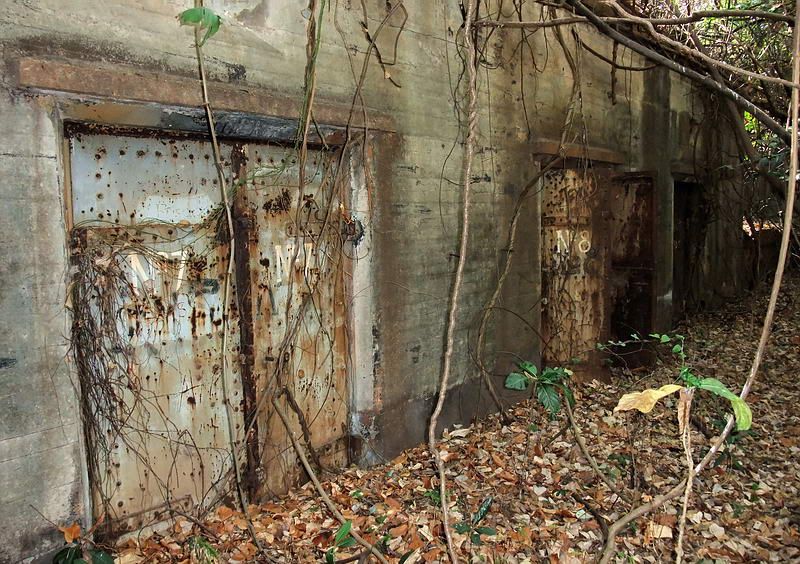
Magazines #7, #8 and #9.
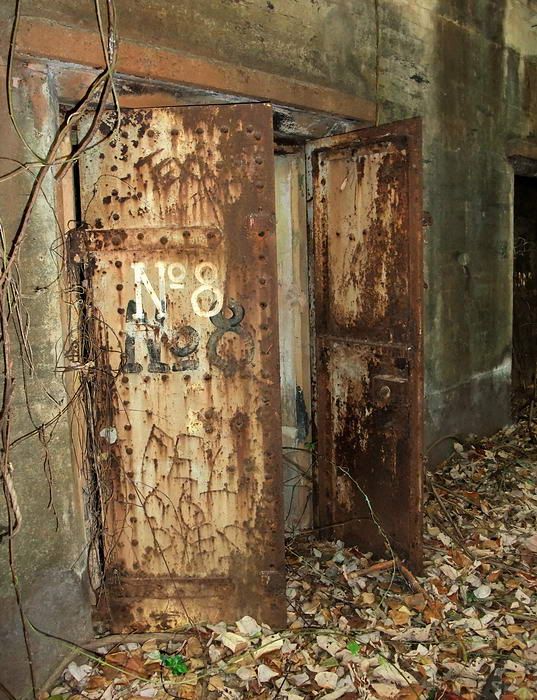
Close-up of Magazine #8.
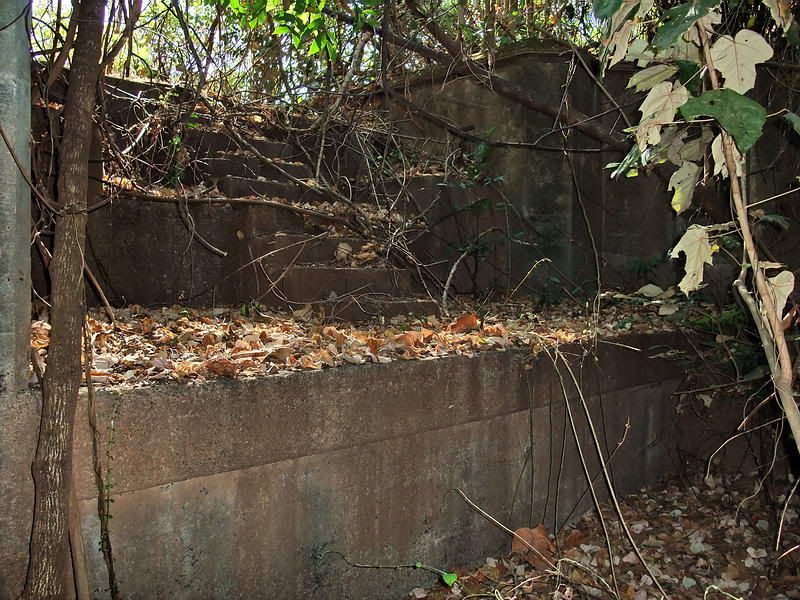
Gun position #1.
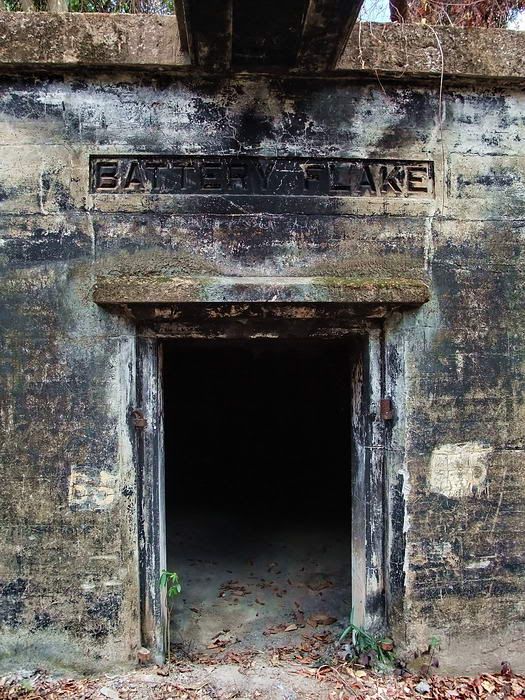
Battery Flake was a twin of Battery Jewell.
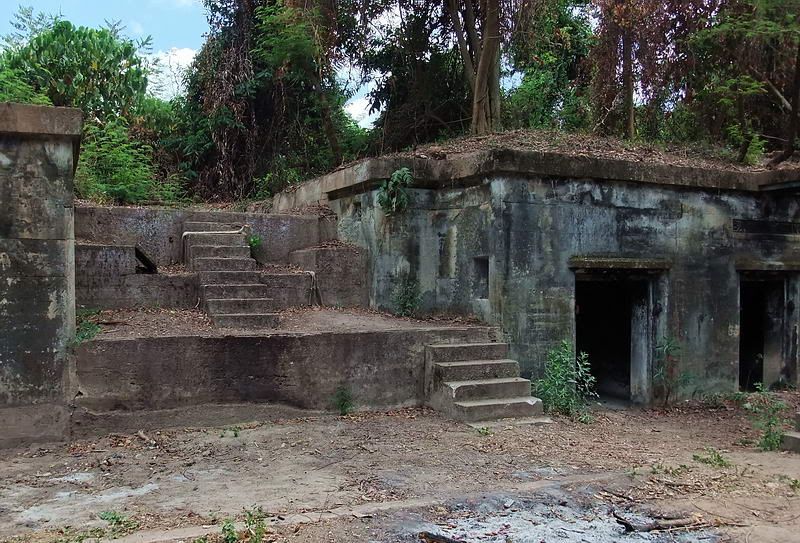
Gun position #3 has just been cleared of vegetation. Ashes at the bottom of the photo were still smoking.

One of the gun positions. You can see the center bolt pattern where the gun mount was attached.
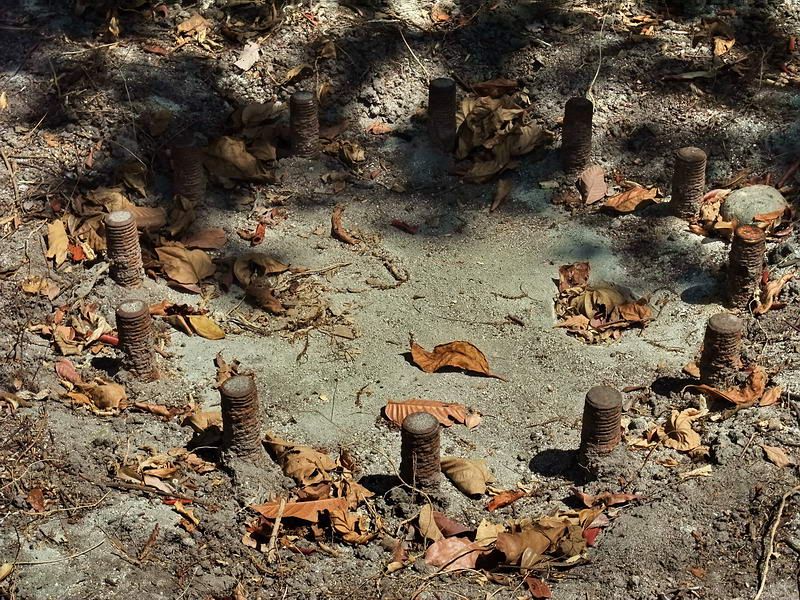
Close-up of the gun mount bolts.
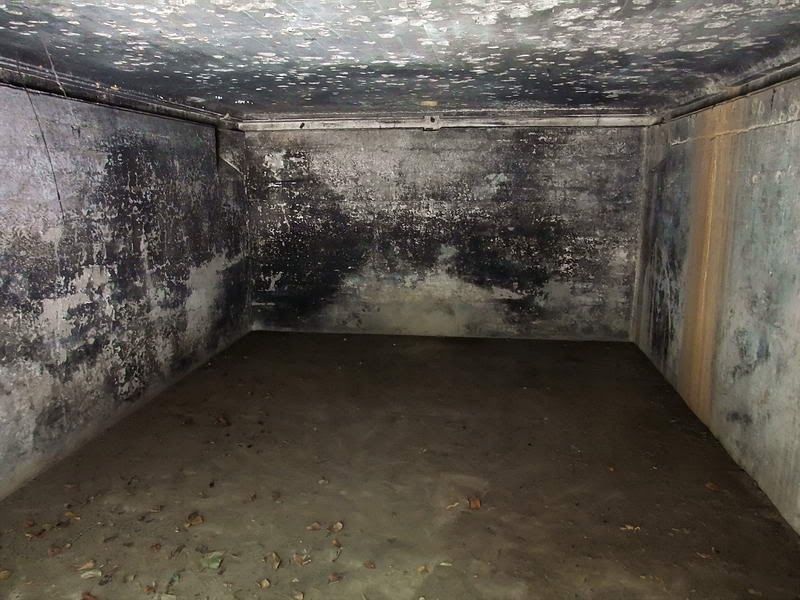
Interior of one of the magazines. Look at all the shrapnel marks in the ceiling and the burned walls. What happened here?
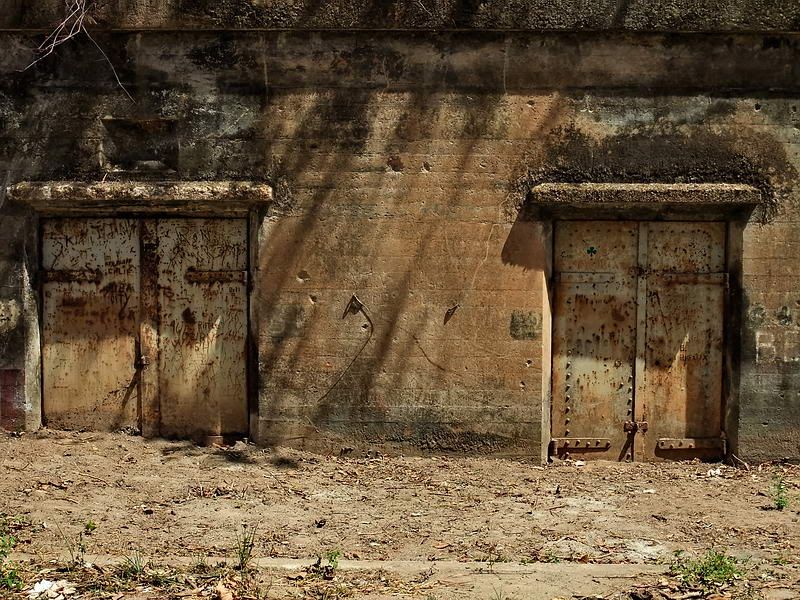
Magazines No.1 and No.2.

A good look at the Battery Control Station and Magazines No.4, No.5 and No.6.

Gun positions #3 and #4 with magazines No.1 to No.3 between them. Steps up to the Battery Control Station are to the far right.
Battery Hall had two 6-inch guns mounted on disappearing carriages. Fortunately both guns are still there for us to see. The center magazine blew up creating a large crater between the guns but I cannot find anything telling me when and why this explosion occurred.

Battery Hall Gun #2.

Battery Hall Gun #2.

Battery Hall Gun #2.

Battery Hall Gun #1.

Battery Hall Gun #1 in the foreground with Gun #2 visible across the clearing. Broken chunks of concrete are all that remains of the center magazine. Note the large concrete block directly below Gun #2. You will see it in the following four photos.

Similar perspective probably taken soon after the explosion. The big crater is just out of sight.

From a little different angle you can see the water filled crater with Gun #2 behind it. (photo courtesy of armyjunk)

The same big chunk of concrete today.

At some time in the past, the crater was filled in.
Battery Woodruff was the other battery with two 6-inch guns mounted on disappearing carriages. Little remains at this site as both guns are gone plus another explosion has obliterated all traces of the magazine. The outer parapet walls are all that can be seen.

The parapet wall in front of the Gun #1 position.

The parapet wall in front of the Gun #2 position.

Steps to the left of the Gun #2 position.
Buildings that look post war are in the area of Battery Woodruff. All are in quite bad shape and nothing indicates what they were used for or whether they were Army or Navy owned.

One of the heavily damaged buildings.

Another of these buildings.

This building was definitely military.
Karl asked me to have a look at the swimming pool that is located here. I thought I was in the correct location but all I saw was piles of garbage and junk. After a few minutes walking around it made sense.

No more swimming here Karl.
Time was running out so I headed back to catch the ferry. Here are a few more photos I took while waiting for it to depart.

The big wave pool that used to be the ball fields during R&R days. From the looks of the vines and grass, it has not operated for a long time.

I am not sure what this is supposed to be but here is the view out the back door of some guest rooms.

The best beach on Grande Island is a short walk from the Resort. By Philippines standards, this one is not impressive.

This pool looks ok. It also occupies part of what was the ball fields.

Along the sea wall looking further into Subic Bay.

At the sea wall looking back towards the dock.

Near the Reception and Restaurant.



On the ferry waiting to go back to Olongapo. There were very few day tour and overnight guests on the island.

The view looking across part of Subic Bay.
For anyone deciding if they want to stay on the island, this is Grande Island Resort website: www.grandeislandresort.com/index.html
Here is a link to the TripAdvisor web site. Reviews of this Resort average at a dismal 70% thumbs down. I have never heard of such bad results before. www.tripadvisor.com/Hotel_Review-g424959-d1065192-Reviews-Grande_Island_Resort-Subic_Luzon.html
For June and July (low season), the rate for a room has been reduced to P6,000/room/night. That is equivalent to approximately $140 USD.
My impression of the Resort: It has an overall ‘lack of maintenance’ look that you can feel as you wander around. Examples are cracked pool-side chairs, garbage cans full when I arrived and not emptied by the time I departed, the electrical box on the outside wall of one room had the door open exposing the circuit breakers to the elements, two pathway nightlights had broken shades (1 missing bulb), the wave pool has been out of service for months (or more), beside a storage/maintenance building were rusty (obviously unused) lawn mowers etc that are in full sight of guests who choose to go for a walk toward the batteries, the ferry was late. I passed on the buffet so cannot comment on it.
None of this is really earth shattering but still shows a general poor attitude or state of things there. From what I saw and have read, I would not bring my family there for an overnight trip even if the price was 1/3 of what it is now. I will say that the staff I spoke to were very friendly and helpful. No complaints there.

Late afternoon shot of Grande Island.

Approaching Olongapo.

Back at the Grande Island Ferry Terminal.
Karl said that I would probably run out of time while exploring and he was correct. This island is not large but it still takes awhile to get to remoter areas through the vegetation. There are many structures that I did not see. Overall it was a good day exploring new territory and I will plan for another trip back here next year.

Map of Subic Bay (herephilippines.co.uk/subicbaymaps.aspx)
Due to the island's limited size it was proposed to mount two 12-inch and four 6-inch disappearing guns. This was later changed to two 10-inch and four 6-inch disappearing guns and six 3-inch guns all mounted in five batteries. The fortifications were assigned the name Fort Wint in honor of Brigadier General Theodore J. Wint who had served in the U.S. Army during the Civil War, Indian campaigns, the War with Spain and the Philippine Insurrection. Fort Wint's batteries were assigned the name of Warwick, 10-inch; Woodruff and Hall, 6-inch, and Jewell and Flake, 3-inch.
The 10-inch disappearing guns as installed at Fort Wint were model 1895 guns manufactured in 1903 and 1906 by the Army's Watervliet Arsenal in New York and were mounted on model 1901 carriages. The 6-inch guns were model 1905 while the 3-inch guns were model 1903. The 10-inch and 6-inch guns were never removed during the life of Fort Wint but four of the 3-inch guns were removed during the 1930s. Only one of these 3-inch guns was ever replaced and that was with a naval 3-inch gun. To properly operate these guns at Fort Wint and the proposed defensive mine field in front of Subic Bay, the Army in 1915 stated that Fort Wint's wartime complement would be 22 officers and 448 men of whom 19 officers and 319 men would man the fort's guns.

1921 map of Grande Island
During the decades of the 1920s and thirties Fort Wint was maintained only on a caretaker basis. This was the result of a 1921 cut in personnel of the Philippine Coastal Defense from 3,600 to 800 men; but the force was later increased by 1,600 Philippine Scouts, native Filipinos serving in the U.S. Army. To train these men Fort Wint was reactivated in 1936 as a Coastal Defense School.
During these two decades no program of modernization was carried out at Fort Wint to update its defensive works in the face of the threat of airpower and improvements in warship construction. This failure was a result of the signing of the Washington Naval Treaty in 1922 which forbade the updating of American outposts in the Pacific. (The above text is from Corregidor.org)

1935 map of Grande Island. When compared to the 1921 map, note fewer structures after years of deactivation.
Post war to the present:
- After a brief period of abandonment the island transformed into an R&R location (fleet recreation area).
- In the 1960s, four 3-inch rapid fire pedestal mount guns and the two 10-inch disappearing guns were removed and reassembled in the US at two Washington State Parks.
- In May 1975, the aircraft carrier USS Hancock (CVA-19) unloaded her cargo of Vietnamese refugees on Grande Island. This temporary processing center was their first stop after the fall of Saigon.
- Today a portion of the island has been converted into a tourist resort.

Aerial view of Grande Island during its R&R days. Note the two ball fields.

Google satellite view of Grande Island. The ball fields are now a swimming pool (aqua) and a wave pool (green). In the photo, the resort covers the top beach part of the island including the dock. The batteries are all hidden by vegetation with the exception of the big 10-inch gun battery (Warwick) which appears near the bottom.

Fort Wint Dock (1940 or 1941, Paul Cornwallis photo)

(1940 or 1941, Paul Cornwallis photo)

Engineer’s Quarters and Post Exchange (1940 or 1941, Paul Cornwallis photo)

Post Hospital Dispensary (1940 or 1941, Paul Cornwallis photo)

Battery Warwick 10-inch gun on a disappearing carriage

Loading one of Battery Warwick’s guns

Fort Wint’s 10-inch guns are now located at Fort Casey, Washington.

Another view of Fort Casey.

A sample of the 3-inch Rapid Fire pedestal mount guns that were installed in Batteries Jewell and Flake. (photo not from Fort Wint)

A sample of the 3-inch Rapid Fire pedestal mount guns that were installed in Batteries Jewell and Flake. (photo not from Fort Wint)

One of the 6-inch guns mounted on a disappearing carriage. Batteries Hall and Woodruff each had two of them. (1968 photo, source unknown)

One of the 6-inch guns mounted on a disappearing carriage. Batteries Hall and Woodruff each had two of them. (1968 photo, source unknown)
To visit Grande Island today requires a ride on a ferry operated by the resort. You can stay overnight if you wish or just book the day trip as I did.

The Grande Island Resort ferry terminal

The ferry is waiting at the dock.

Grande Island Resort ferry.

Looking along the dock. Subic Bay is surrounded by mountains.

As you approach Grande Island all the buildings we see belong to the resort.

After twenty minutes or so on the ferry you arrive at the Grande Island dock.

Looking down the dock towards the Reception and Restaurant building.

View of the beach in front of the resort.

Layout of the Resort. I will show more of the Grande Island Resort later.
After side stepping a couple employees trying to herd me into the restaurant, I start my exploration of what was Fort Wint.
The first thing I notice is that the island is larger than I anticipated. Maps and photos are deceiving until you get your feet on the ground. Also, old maps do not show any of the current roads/paths so I actually found it a bit confusing at first. Now that I have my bearings the next trip will be much more efficient.

Away from the Resort, I see the first of three guard towers.
Since time was limited I decided to hit the main sites first. The most impressive is Battery Warwick which survived the war intact. Even though both big 10-inch guns are gone, it is still interesting to walk around. Immediately I notice that years of scrapping has not taken place here or at least, not so extensively. Most original metal doors and screens remain where only a few still exist on all of Corregidor Island.

Battery Warwick behind the Gun #1 position. Note the slanted building to the right. There is some structural failure at this corner of the battery. The parapet seems to be collapsing here.

Note the metal doors still there and no battle damage to the concrete.

Gun #2 position is full of grass now.

Looking across the battery from near the Gun #2 position.
I had better explain the ‘Alien landing site’ you see here. This is the antenna for an aircraft navigational aid known as DVOR (Doppler VHF Omnidirectional Radio range).
So why does this radar antenna look so strange? The answer is simple. “Although older antennas were mechanically rotated, current installations scan electronically to achieve an equivalent result with no moving parts”.
I assume it is not in-service now as the place was abandoned. The radar was scavenged for parts last year when a similar DVOR in Manila failed. The nearby Subic Bay International Airport (former Cubi Point NAS) is losing money since FedEx left and there is talk of closing it.

Closer view of the radar antenna.

Another view.

This is the area where powder and shells for the guns was brought up from the magazines below. These look like original doors also.

To the right of Gun #2.

The outer solid metal doors have inner barred doors which I have not seen before. This concrete stairway leads down to the magazines.

Rear door to one of the magazines.

Magazine interior looking towards the front door. The inner door with bars rolls on a track.

Stairs up to the Gun #1 position.

Gun #1 position.

The view from the rocky shore at the opposite side of the island from the Resort. This is the wider of the two channels leading into Subic Bay. The blue buildings in the distance is the Korean Shipyard.

To the south of Grande Island is Chiquita Island. This low tide view makes it look like I could walk over there.

Another low tide view. Big clouds created quite a bit of contrast that day.
Battery Jewell had four 3-inch Rapid Fire guns mounted on pedestals. Between each of the gun positions were three reinforced rooms (total of nine) in which I assume most or perhaps all were magazines. This design made the battery quite long but narrow. In the center of the battery were double steps to the Battery Control Station. All guns are gone now.

Rear view of half of Battery Jewell. Gun position #4 is in the foreground and the arched area with the pipes on top is the Battery Control Station. The wire fence surrounds part of the battery which was used years ago as some sort of radio station. It is abandoned now.

Gun position #4 is at the top of the steps.

The three magazines between guns #3 and #4. The rooms seem to be storage places for the Resort’s miscellaneous junk.

Gun position #3 is at the top of the steps. This position is unusual in that the metal gun mount is still there.

Gun #3 mount.

Close-up of the mount looking towards the front of the position.

Standing beside Battery Control looking across gun positions #3 and #4. Magazines No.1, No.2 and No.3 are between those positions. Magazines No.4, No.5 and No.6 are almost under me and No.7, No.8 and No.9 are to my right.

Does anyone know why Battery Jewell in now misspelled?

Magazine #5.

Gun position #2.

Magazines #7, #8 and #9.

Close-up of Magazine #8.

Gun position #1.

Battery Flake was a twin of Battery Jewell.

Gun position #3 has just been cleared of vegetation. Ashes at the bottom of the photo were still smoking.

One of the gun positions. You can see the center bolt pattern where the gun mount was attached.

Close-up of the gun mount bolts.

Interior of one of the magazines. Look at all the shrapnel marks in the ceiling and the burned walls. What happened here?

Magazines No.1 and No.2.

A good look at the Battery Control Station and Magazines No.4, No.5 and No.6.

Gun positions #3 and #4 with magazines No.1 to No.3 between them. Steps up to the Battery Control Station are to the far right.
Battery Hall had two 6-inch guns mounted on disappearing carriages. Fortunately both guns are still there for us to see. The center magazine blew up creating a large crater between the guns but I cannot find anything telling me when and why this explosion occurred.

Battery Hall Gun #2.

Battery Hall Gun #2.

Battery Hall Gun #2.

Battery Hall Gun #1.

Battery Hall Gun #1 in the foreground with Gun #2 visible across the clearing. Broken chunks of concrete are all that remains of the center magazine. Note the large concrete block directly below Gun #2. You will see it in the following four photos.

Similar perspective probably taken soon after the explosion. The big crater is just out of sight.

From a little different angle you can see the water filled crater with Gun #2 behind it. (photo courtesy of armyjunk)

The same big chunk of concrete today.

At some time in the past, the crater was filled in.
Battery Woodruff was the other battery with two 6-inch guns mounted on disappearing carriages. Little remains at this site as both guns are gone plus another explosion has obliterated all traces of the magazine. The outer parapet walls are all that can be seen.

The parapet wall in front of the Gun #1 position.

The parapet wall in front of the Gun #2 position.

Steps to the left of the Gun #2 position.
Buildings that look post war are in the area of Battery Woodruff. All are in quite bad shape and nothing indicates what they were used for or whether they were Army or Navy owned.

One of the heavily damaged buildings.

Another of these buildings.

This building was definitely military.
Karl asked me to have a look at the swimming pool that is located here. I thought I was in the correct location but all I saw was piles of garbage and junk. After a few minutes walking around it made sense.

No more swimming here Karl.
Time was running out so I headed back to catch the ferry. Here are a few more photos I took while waiting for it to depart.

The big wave pool that used to be the ball fields during R&R days. From the looks of the vines and grass, it has not operated for a long time.

I am not sure what this is supposed to be but here is the view out the back door of some guest rooms.

The best beach on Grande Island is a short walk from the Resort. By Philippines standards, this one is not impressive.

This pool looks ok. It also occupies part of what was the ball fields.

Along the sea wall looking further into Subic Bay.

At the sea wall looking back towards the dock.

Near the Reception and Restaurant.



On the ferry waiting to go back to Olongapo. There were very few day tour and overnight guests on the island.

The view looking across part of Subic Bay.
For anyone deciding if they want to stay on the island, this is Grande Island Resort website: www.grandeislandresort.com/index.html
Here is a link to the TripAdvisor web site. Reviews of this Resort average at a dismal 70% thumbs down. I have never heard of such bad results before. www.tripadvisor.com/Hotel_Review-g424959-d1065192-Reviews-Grande_Island_Resort-Subic_Luzon.html
For June and July (low season), the rate for a room has been reduced to P6,000/room/night. That is equivalent to approximately $140 USD.
My impression of the Resort: It has an overall ‘lack of maintenance’ look that you can feel as you wander around. Examples are cracked pool-side chairs, garbage cans full when I arrived and not emptied by the time I departed, the electrical box on the outside wall of one room had the door open exposing the circuit breakers to the elements, two pathway nightlights had broken shades (1 missing bulb), the wave pool has been out of service for months (or more), beside a storage/maintenance building were rusty (obviously unused) lawn mowers etc that are in full sight of guests who choose to go for a walk toward the batteries, the ferry was late. I passed on the buffet so cannot comment on it.
None of this is really earth shattering but still shows a general poor attitude or state of things there. From what I saw and have read, I would not bring my family there for an overnight trip even if the price was 1/3 of what it is now. I will say that the staff I spoke to were very friendly and helpful. No complaints there.

Late afternoon shot of Grande Island.

Approaching Olongapo.

Back at the Grande Island Ferry Terminal.
Karl said that I would probably run out of time while exploring and he was correct. This island is not large but it still takes awhile to get to remoter areas through the vegetation. There are many structures that I did not see. Overall it was a good day exploring new territory and I will plan for another trip back here next year.






 There seems to be no reason for "shoring" up the structure, therefore destroying the two letters. I just cannot feature any reason to smear concrete,etc over those two missing letters.
There seems to be no reason for "shoring" up the structure, therefore destroying the two letters. I just cannot feature any reason to smear concrete,etc over those two missing letters. 









